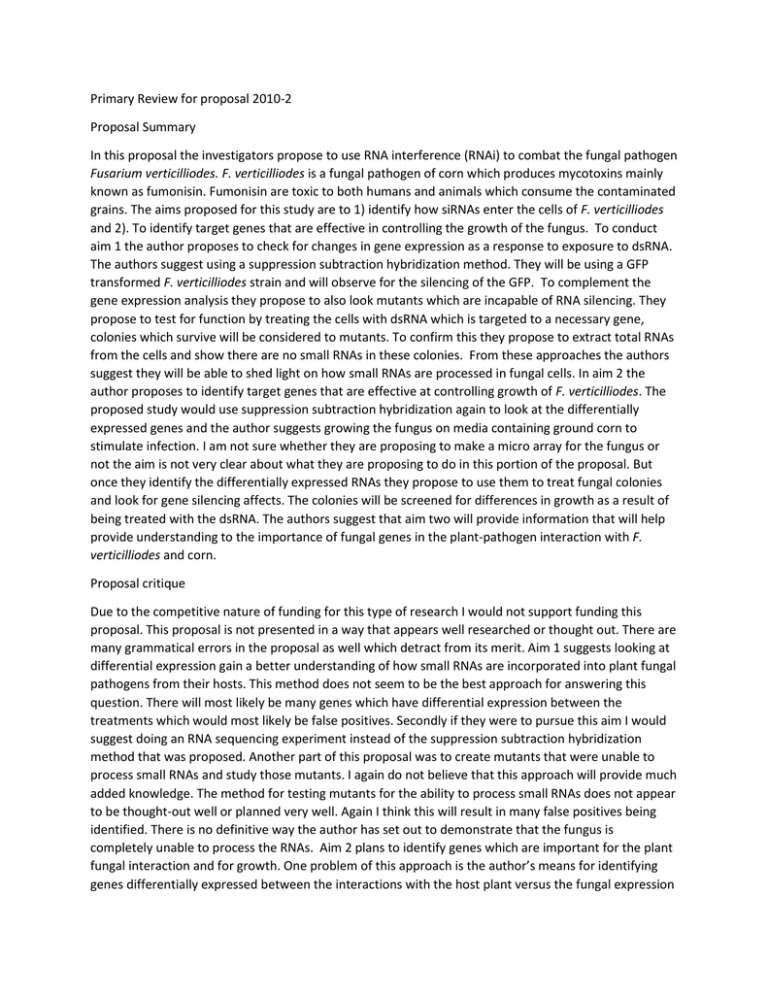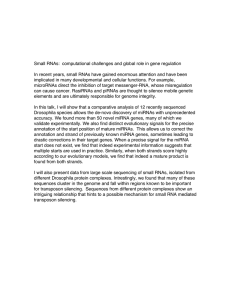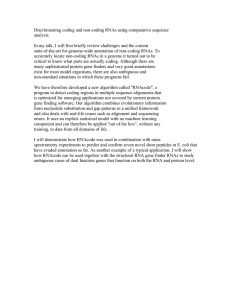Primary Review for proposal 2010-2 Proposal Summary
advertisement

Primary Review for proposal 2010-2 Proposal Summary In this proposal the investigators propose to use RNA interference (RNAi) to combat the fungal pathogen Fusarium verticilliodes. F. verticilliodes is a fungal pathogen of corn which produces mycotoxins mainly known as fumonisin. Fumonisin are toxic to both humans and animals which consume the contaminated grains. The aims proposed for this study are to 1) identify how siRNAs enter the cells of F. verticilliodes and 2). To identify target genes that are effective in controlling the growth of the fungus. To conduct aim 1 the author proposes to check for changes in gene expression as a response to exposure to dsRNA. The authors suggest using a suppression subtraction hybridization method. They will be using a GFP transformed F. verticilliodes strain and will observe for the silencing of the GFP. To complement the gene expression analysis they propose to also look mutants which are incapable of RNA silencing. They propose to test for function by treating the cells with dsRNA which is targeted to a necessary gene, colonies which survive will be considered to mutants. To confirm this they propose to extract total RNAs from the cells and show there are no small RNAs in these colonies. From these approaches the authors suggest they will be able to shed light on how small RNAs are processed in fungal cells. In aim 2 the author proposes to identify target genes that are effective at controlling growth of F. verticilliodes. The proposed study would use suppression subtraction hybridization again to look at the differentially expressed genes and the author suggests growing the fungus on media containing ground corn to stimulate infection. I am not sure whether they are proposing to make a micro array for the fungus or not the aim is not very clear about what they are proposing to do in this portion of the proposal. But once they identify the differentially expressed RNAs they propose to use them to treat fungal colonies and look for gene silencing affects. The colonies will be screened for differences in growth as a result of being treated with the dsRNA. The authors suggest that aim two will provide information that will help provide understanding to the importance of fungal genes in the plant-pathogen interaction with F. verticilliodes and corn. Proposal critique Due to the competitive nature of funding for this type of research I would not support funding this proposal. This proposal is not presented in a way that appears well researched or thought out. There are many grammatical errors in the proposal as well which detract from its merit. Aim 1 suggests looking at differential expression gain a better understanding of how small RNAs are incorporated into plant fungal pathogens from their hosts. This method does not seem to be the best approach for answering this question. There will most likely be many genes which have differential expression between the treatments which would most likely be false positives. Secondly if they were to pursue this aim I would suggest doing an RNA sequencing experiment instead of the suppression subtraction hybridization method that was proposed. Another part of this proposal was to create mutants that were unable to process small RNAs and study those mutants. I again do not believe that this approach will provide much added knowledge. The method for testing mutants for the ability to process small RNAs does not appear to be thought-out well or planned very well. Again I think this will result in many false positives being identified. There is no definitive way the author has set out to demonstrate that the fungus is completely unable to process the RNAs. Aim 2 plans to identify genes which are important for the plant fungal interaction and for growth. One problem of this approach is the author’s means for identifying genes differentially expressed between the interactions with the host plant versus the fungal expression on media. Secondly RNA sequencing would be a more appropriate method for this analysis if you were to compare the fungus growing in media versus the infected plant tissue and use bioinformatics to pull out the sequences which are from corn in the interaction samples. Overall I would not support funding this proposal because there is no big picture presented here and the two aims are not very cohesive. Secondly the aims do not appear to be well prepared or well thoughtout. I feel there would be little useful information gathered from either of the aims. The budget and the time requested for this project when considered with the possible outcomes is too expensive to fund.






